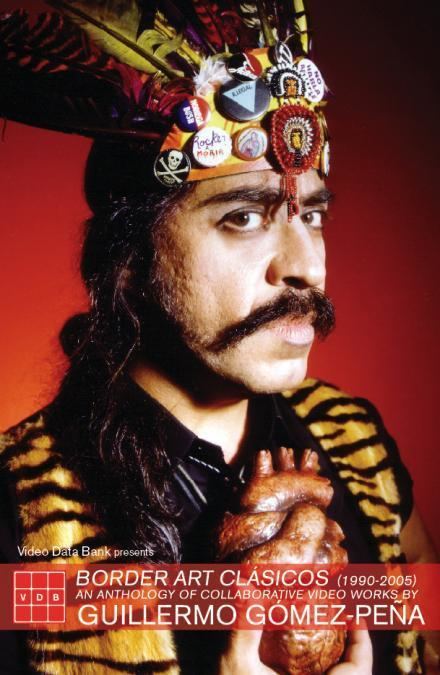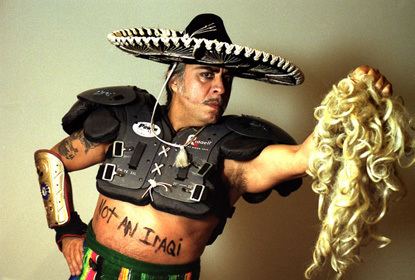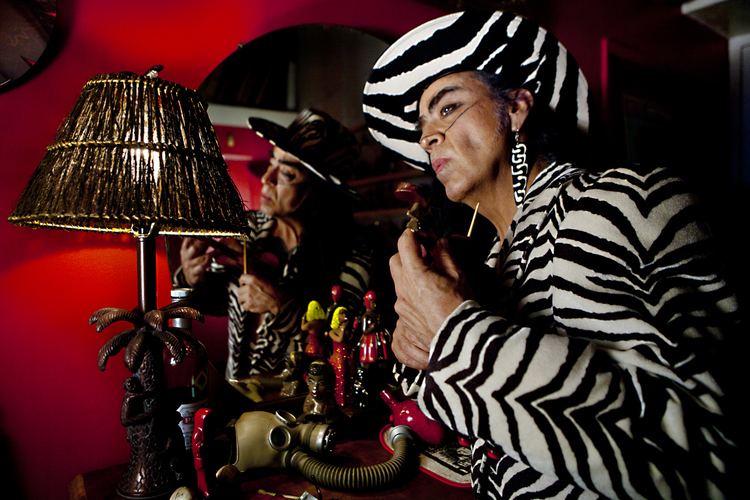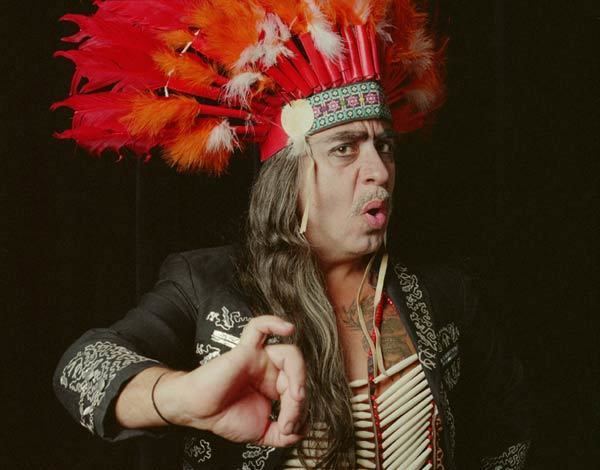Name Guillermo Gomez-Pena Role Artist | Movies Seeing Is Believing | |
 | ||
Awards American Book Awards, MacArthur Fellowship Books The New World Border, Ethno‑techno, Codex espangliensis, Dangerous border crossers, Warrior for gringostroika | ||
Radical art radical communities and radical dreams guillermo g mez pe a at tedxcalarts
Guillermo Gómez-Peña is a Chicano performance artist, writer, activist, and educator. Gómez-Peña has created work in multiple media, including performance art, experimental radio, video, photography and installation art. His ten books include essays, experimental poetry, performance scripts and chronicles in both English, Spanish and Spanglish. He is a founding member of the art collective Border Arts Workshop/Taller de Arte Fronterizo and director of the performance art troupe La Pocha Nostra.
Contents
- Radical art radical communities and radical dreams guillermo g mez pe a at tedxcalarts
- Guillermo g mez pe a unplugged
- Early life
- Work
- La Pocha Nostra
- Collaboration with Coco Fusco
- Additional Collaborations
- Awards and honors
- References

Gómez-Peña has contributed to cultural debates for nearly 30 years staging seminal performance art pieces including Couple in The Cage: Two Undiscovered Amerindians Visit the West (with Coco Fusco, 1992-93), The Crucifiction Project (with Roberto Sifuentes, 1994), Temple of Confessions (1995), The Mexterminator Project (1997–99),The Living Museum of Fetishized Identities, (1999-2002), the Mapa/Corpo series (2004-2009), Corpo Ilicito (2010-2011) and most recently Corpo Insurrecto (2012-2013). His performance work mixes experimental aesthetics, activist politics, Spanglish humor and audience participation to create a "total experience" for the audience member/reader/viewer.

Guillermo g mez pe a unplugged
Early life

Guillermo Gómez-Peña was born in Mexico City in 1955. He studied Linguistics and Latin American Literature at National Autonomous University of Mexico (UNAM) from 1974–1978. He moved to the US in 1978 and studied at California Institute of the Arts, earning a B.A. in 1981 and an M.A. in 1983.
Work

From 1983 until 1990, Gómez-Peña lived in the San Diego/Tijuana border region. Most of his artistic and intellectual work concerns the interface between North and South (Mexico and the U.S.), border culture and the politics of the brown body. His original interdisciplinary arts projects and books explore borders, physical, cultural and otherwise, between his two countries and between the mainstream U.S. and the various Latino cultures: the U.S.-Mexico border itself, immigration, cross-cultural and hybrid identities, and the confrontation and misunderstandings between cultures, languages and races. Gómez-Peña was a founding member of Border Arts Workshop/Taller de Arte Fronterizo, an international arts collective based at the Centro Cultural de la Raza in San Diego.

His artwork and literature also explore the politics of language, the side effects of globalization, "extreme culture," the culture of violence and new technologies from a Latino perspective. He is a patron of the London-based Live Art Development Agency and a Senior Fellow of the Hemispheric Institute of Performance and Politics (NYU).
La Pocha Nostra

Gómez-Peña is the artistic director of the international performance troupe La Pocha Nostra. La Pocha Nostra is a trans-disciplinary arts organization that provides a support network and forum for artists of various disciplines, generations and ethnic backgrounds. La Pocha is devoted to erasing the borders between art and politics, art practice and theory, artist and spectator. La Pocha Nostra has intensely focused on the notion of collaboration across national borders, race, gender and generations as an act of radical citizen diplomacy and as a means to create temporary communities of rebel artists. Every year, La Pocha conducts a summer and a winter performance art school in which Pocha’s radical pedagogy (a performance methodology that has been developed during the last 10 years) is shared with an international group of rebel artists.

Gómez-Peña's work with La Pocha Nostra has been presented across the US, Canada, Mexico, Latin America, Europe, Russia, Australia and South Africa. In recent years, the troupe has presented work at Tate Modern (London), Arnolfini (Bristol), the Guggenheim Museum (New York), LACMA (Los Angeles), the House of World Cultures and the Volksbuhne (Berlin), MACBA (Barcelona), El Museo de la Ciudad (Mexico City) and the Encuentros Hemisféricos in Lima, Rio de Janeiro, Belo Horizonte, Buenos Aires and São Paulo. Gomez-Peña and La Pocha Nostra have participated in the following Biennales: Havana,The Withney, Sydney, Liverpool, Thessaloniki and Mercosur. The troupe’s photo performances are now in the permanent collection of Daros Foundation (Zurich) and Galeria Artificios (Gran Canaria).
Collaboration with Coco Fusco
Gómez-Peña traveled internationally for two years with fellow artist Coco Fusco performing The Year of the White Bear and Two Undiscovered Amerindians Visit the West (1992–1994), a satirical performance piece in which the two artists were exhibited in a cage in museums and at arts festivals as "authentic" Amerindians from a previously undiscovered island off the Mexican coast. The pair dressed up in a hodgepodge of ethnic drag and bits of Americana such as a baseball cap and grass skirt in the case of Fusco, and face paint and a leopard-skin wrestling mask for Gómez-Peña. Coco Fusco described the piece as "a satirical commentary both on the Quincentenary celebrations and on the history of this practice of exhibiting human beings from Africa, Asia, and Latin America in Europe and the United States in zoos, theaters, and museums." During its run, the critically acclaimed piece was performed at major museums and arts festivals in New York, Washington, DC, Los Angeles, Chicago and Madrid, Spain, amongst others.
The Year of the White Bear was sometimes accompanied by a performance piece entitled New World (B)Order, which Chicago Reader art critic Carmela Rago called "the denouement of the performance installation at the Field Museum; using irony and humor Gomez-Pena and Fusco allowed us to contemplate the next step--being part of a world border culture, reclaiming our humanity and our hearts." The artists also worked with filmmaker Paula Heredia to create The Couple in the Cage: Guatianaui Odyssey, a documentary that records several performances for The Year of the White Bear as well as viewer reactions to the work.
Additional Collaborations
Besides working in an ongoing basis with La Pocha Nostra (Emma Tramposch, Roberto Sifuentes, Michele Ceballos, Violeta Luna, Dani d'Emilia, Saul Garcia Lopez, Erica Mott and Daniel Brittany Chavez). Gómez-Peña was a member of the San Diego-based Border Arts Workshop/Taller de Arte Fronterizo (BAW/TAF) art collective which also included artist Emily Hicks, Bertha Jottar, Richard Lou, Victor Ochoa, Robert Sanchez, Michael Schnorr and Rocío Weiss. Gómez-Peña has done collaborative art projects and with James Luna, Reverend Billy, Tania Bruguera, Richard Montoya and Sara Shelton Mann.
